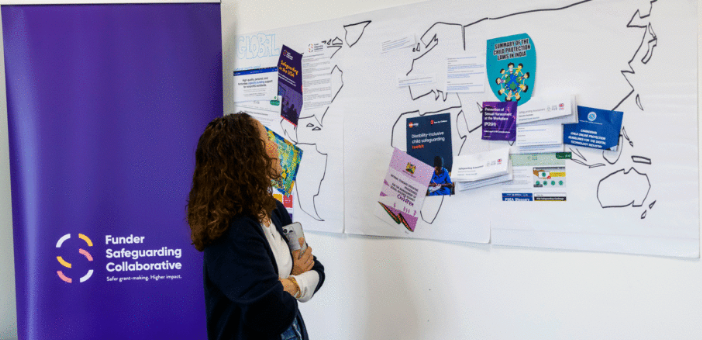From Political Backlash to Program Cuts: Why Safety Must Be a Philanthropic Priority

By Steina Bjorgvinsdottir, Executive Director of Funder Safeguarding Collaborative, and John Hecklinger, Co-CEO of Global Fund for Children
Across the United States, nonprofits and funders alike are navigating a shifting landscape. Funding streams are narrowing. Polarized political rhetoric is fueling mistrust in the sector. And while calls for greater accountability are growing louder, they often come without the support needed to meet them.
In this climate, it’s not enough to ask whether individual organizations are doing enough to protect the people they serve. We must also consider the responsibility that funders hold in cultivating a sector-wide environment of safety and dignity.
This is not about risk mitigation or crisis response alone. It’s about shared accountability, ensuring that the pursuit of positive change never puts anyone in harm’s way. That includes deliberate, values-driven action to prevent abuse or exploitation, and to promote the well-being of everyone connected to an organization: staff, partners, program participants, and communities.
In much of the world, this work is referred to as “safeguarding.” In the U.S., the language may be less familiar, but the need is urgent and funders have a critical role to play.
The Case for Action
The Funder Safeguarding Collaborative (FSC), fiscally sponsored and co-founded by Global Fund for Children, exists to support funders in building safer practices, within their own institutions and in support of their grantee partners. Our network of more than 100 funders globally manage over $8 billion in annual grantmaking. What unites us is a belief that safety, dignity, and accountability are foundational to effective philanthropy.
In 2024, FSC mapped the current state of “safeguarding” in the US. What we found was a sector in motion, but with serious gaps:
- There is no consistent legal or regulatory framework across states governing organizational responsibility for safety or wellbeing, leaving nonprofits without clear guidance.
- Nonprofits trying to strengthen their practices often lack access to resources, peer learning, or expert support.
- The term safeguarding is rarely used and often misunderstood, leading to fragmented or narrow interpretations.
This fragmentation leaves too many organizations vulnerable to reputational risk and legal exposure, but more importantly, to the deeper failure of not protecting the very people nonprofits and philanthropy exists to serve.
Philanthropy Under Pressure
The stakes are rising. We’ve seen how a single scandal, like the revelations of abuse in U.S. gymnastics that came to light in 2018, can reverberate, fueling mistrust and triggering funding withdrawals. Although often described as individual misconduct, this was in fact a safeguarding failure – and in today’s political climate, another high-profile failure could be weaponized to attack not just one organization, but the entire sector.
At the same time, widespread funding cuts are putting pressure on core infrastructure that help organizations prevent harm and respond when it occurs. These cuts don’t just shrink programs. They erode the safeguards that make those programs safe, inclusive, and sustainable.
Now more than ever, funders must recognize that protecting people is not an optional extra. It is central to mission integrity, to community trust, and to the legitimacy of philanthropy itself.
Turning Principles Into Practice
At the Council on Foundations’ Leading Locally 2025 conference in Minneapolis, we co-hosted a session focused on the role of place-based funders in advancing safety and accountability. We heard from funders that, with the right support, grantee organizations are embedding safety into the fabric of their operations, through practical tools, honest reflection, and community-driven action.
The message was clear: this work is possible. And it’s already happening.
We also aligned on key actions funders can take right now:
- Build a culture of safety: Embed clear expectations into policies, support open communication, and model values of respect and dignity.
- Prevent harm proactively: Use risk assessments, train staff and partners, and ensure safe recruitment and reporting systems.
- Respond effectively: Establish confidential mechanisms to report concerns, and act swiftly and compassionately when harm is suspected.
These aren’t abstract ideals. They’re operational commitments that touch everything from HR to DEI to program design – and that ultimately shape the experience of the people philanthropy is meant to serve.
What Comes Next?
Despite the complexity of the moment, we see opportunity. We’re committed to continuing our work to strengthen resources, capacity, and community around safeguarding in the US, and we’re looking to grow this work alongside others who share that commitment.
If you’re a funder exploring how to advance safety and accountability in your own work, or interested in supporting broader change across the sector, we invite you to connect with us. Whether you’re just beginning this journey or already investing in it, there are meaningful ways to get involved.
Let’s ensure that keeping people safe is not a reactive measure, but a defining feature of how philanthropy shows up – resourced, intentional, and grounded in care.
Help to co-create safeguarding standards for funders
As part of our ongoing collaboration with Accountable Now, Funder Safeguarding Collaborative is inviting funders, grantees and independent professionals to participate in a global survey to inform the co-creation of practical, evidence-based safeguarding standards for funders.
In a time when safeguarding work remains more important than ever, Funders have an important role to play in motivating action and ensuring accountability for safeguarding, in their own organisations and in the organisations they fund. At present, however, very little is known about the most effective ways for funders to promote safer practice. By developing evidence-based standards, the aim is to equip funders to uphold the ‘do no harm’ principle and implement measures that are relevant, feasible and effective.
Survey closes 25 June 2025
Doing good, wrong? The role of philanthropy in keeping people safe
By Steina Bjorgvinsdottir, Executive Director, Funder Safeguarding Collaborative

Philanthropy invests billions of dollars annually to address pressing social issues. However, the positive impact of these contributions can be undermined when organizations fail to prioritize the safety and well-being of the people they serve. Funders in the United States can address this risk by promoting safeguarding—proactive measures taken to prevent all forms of harm, abuse, and exploitation to all individuals who interact with funders and the organizations they support.
In well documented cases of international aid organizations operating in Haiti, weak safeguarding measures led to the sexual exploitation of the very people those groups exist to serve. Those cases sparked awareness among many funders of their role in incentivizing safety and their obligations when failures occur at grantee organizations.
The Funder Safeguarding Collaborative (FSC)—fiscally sponsored and co-founded by Global Fund for Children—works to create organizational practices and cultures in support of safeguarding. This article will highlight findings from a recent FSC report analyzing the challenges its U.S. members face in promoting safeguarding, opportunities, and promising practices.
Addressing power imbalances and structural inequities
A critical aspect of promoting safeguarding is acknowledging and addressing the power imbalances within the philanthropic sector as well as the structural inequities that often place marginalized populations at greater risk of harm.
In recent years, there has been increasing attention on the need for funders to shift power to grantees. Safeguarding must be part of this conversation, ensuring that vulnerable populations are not only protected from harm but also empowered to advocate for their own safety and well-being. Funders have a responsibility to ensure that their safeguarding measures do not replicate harmful systems, such as mandatory reporting requirements that disproportionately impact BIPOC (Black, Indigenous, and people of color) communities.
Challenges in promoting safeguarding practices
The safeguarding landscape in the U.S. is complex, with inconsistent regulations and varying levels of understanding across states and sectors. Key challenges funders face in promoting safeguarding include:
- Lack of clear communication around safeguarding: Many organizations equate safeguarding solely with mandatory child abuse reporting, missing the broader scope of responsibilities. Those responsibilities range from ensuring the safety and well-being of foundation and grantee staff working in difficult environments, protecting the privacy of grantees and program participants, and creating a culture of safeguarding within an organization to prevent harm from occurring in the first place.
- Inconsistent legal and regulatory framework: While federal laws such as the Child Abuse Prevention and Treatment Act provide guidelines for child protection, safeguarding practices for other vulnerable groups and in broader contexts are less defined. At the state level, regulations can vary significantly, creating further complexity for organizations operating across multiple jurisdictions.
- Limited incentives for implementing measures: With little perceived benefit in prioritizing safeguarding and no clear incentives from funders or regulatory bodies, grantees may prioritize other programmatic outcomes, especially in a restrictive funding environment.
- Capacity-building and resource gaps: Many organizations lack the resources or expertise to implement comprehensive safeguarding measures. Training staff and volunteers, developing policies, and establishing incident reporting systems all require significant investment, which is often not prioritized in funding allocations.
Opportunities for promoting safeguarding practices
Despite these challenges, there are numerous opportunities for funders to advance safeguarding by shaping the practices of grantee organizations. By embedding safeguarding into grant requirements, providing resources, and fostering a culture of safety, philanthropy can play a crucial role in preventing harm and ensuring that their work contributes to positive, sustainable change.
Here are three ways funders can proactively promote safeguarding:
- Incentivize safeguarding through funding requirements: By providing additional funding, recognition, or capacity-building opportunities for nonprofits that demonstrate a commitment to safeguarding, funders can incentivize grantees to prioritize these efforts.
- Build organizational capacity: Funders can support grantees by offering resources such as discounted background checks, safeguarding training, and technical assistance in developing policies and procedures to protect vulnerable populations effectively.
- Promote best practices through knowledge sharing: Funders can facilitate knowledge sharing and peer learning so funders and grantees can learn from one another and collectively improve safeguarding practices.
Safeguarding is not a peripheral concern for philanthropy; it is central to ensuring that the work of funders and the organizations they support has a lasting, positive impact. By incentivizing safeguarding, building capacity, and fostering a culture of safety and transparency, funders can help create a safer, more equitable world.
Strengthening safeguarding in philanthropy: A LabStorm with the Funder Safeguarding Collaborative

Keeping people safe isn’t just a moral obligation—it’s a fundamental responsibility for organizations working with communities worldwide. But when it comes to philanthropy, how can funders play an active role in ensuring that safeguarding is embedded in their work? The Funder Safeguarding Collaborative (FSC) is on a mission to answer that question. In a recent LabStorm, we explored how FSC can better equip funders to promote safe, ethical, and accountable grant-making that prioritizes community well-being.
About the Funder Safeguarding Collaborative
Founded in 2021, the Funder Safeguarding Collaborative (FSC) was created by Comic Relief, Global Fund for Children, The National Lottery Community Fund, Oak Foundation, and Porticus to help grantmakers integrate safeguarding principles into their funding practices. Housed within the Global Fund for Children, FSC supports a growing global network of funders, including 22 U.S.-based foundations, in building a world where organizational cultures and practices actively prevent harm.
FSC defines safeguarding as the measures taken to prevent and respond to all forms of harm, abuse, and exploitation for anyone who interacts with a funder or grantee organization. However, in the U.S., “safeguarding” is not commonly understood, making it challenging for FSC to engage funders and nonprofits in adopting these critical practices.
The Challenge
FSC came to this LabStorm with a central question: How can U.S.-based funders be incentivized to embed safeguarding into their grant-making and operational strategies? Key challenges included:
- A lack of common understanding of safeguarding in the U.S. Many organizations equate safeguarding with risk management rather than a proactive commitment to preventing harm.
- Limited incentives for funders to prioritize safeguarding. Unlike in the UK, where regulatory frameworks drive compliance, U.S. funders lack clear external pressures to adopt safeguarding measures.
- Ensuring safeguarding efforts align with trust-based philanthropy. How can funders uphold safeguarding without it feeling imperialistic or overly bureaucratic for grantees?
Key Discussions
1. Reframing Safeguarding for a U.S. Context
One of the biggest barriers FSC faces is terminology. In the U.S., “safeguarding” is often misunderstood or associated with data protection or security measures. Participants explored alternative ways to frame safeguarding in ways that resonate with U.S.-based funders:
- “Keeping People Safe” was suggested as a more accessible phrase that plainly describes the purpose of safeguarding efforts.
- “Abuse Prevention” has been effective for some organizations in opening conversations about risk and accountability.
- “Psychological Safety” was highlighted as an entry point, as many organizations already have internal discussions about workplace well-being and harm prevention.
The group agreed that while safeguarding is a global concept, its language and framing must be adapted to encourage broader adoption in the U.S. philanthropic sector.
2. Creating Incentives for U.S. Funders and Grantees
Since safeguarding is not a formal requirement for U.S. funders, organizations need compelling reasons to prioritize it. The group explored three major incentive structures:
- Mission and Value Alignment: Positioning safeguarding as an integral part of impact-driven philanthropy can motivate funders to see it as a core component of ethical funding.
- Risk Management: Safeguarding can be framed as a proactive strategy to reduce legal and reputational risks, appealing to funders concerned with long-term sustainability.
- Operational Efficiency: Embedding safeguarding across DEI, HR, and operations teams can streamline policies, avoiding duplication and improving internal coordination.
3. Aligning Safeguarding with Trust-Based Philanthropy
One of the biggest concerns raised was whether funders introducing safeguarding requirements for their grantee partners could feel like a top-down, prescriptive process—which runs counter to trust-based philanthropy. Participants explored ways to balance accountability with grantee autonomy:
- Strengths-Based Approaches: Rather than imposing rigid safeguarding requirements and enforcing compliance, funders can work alongside grantees to elevate existing good practices that reflect community understandings of safety and cultural contexts.
- Flexible Implementation: Some funders have successfully adopted a developmental approach, where organizations work toward safeguarding benchmarks over time rather than facing immediate compliance demands.
- Integrating Safeguarding into Learning Cohorts: Establishing peer networks where grantees can exchange ideas and co-design solutions makes safeguarding feel collaborative rather than enforced.
By shifting from compliance-driven safeguarding to a grantee-led, co-created model, funders can build mutual trust while still prioritizing safety and accountability.
Key Takeaways
- Language matters. Adapting safeguarding terminology for a U.S. audience—such as using “Keeping People Safe” or “Abuse Prevention”—can improve understanding and buy-in.
- Funders need clear incentives. Mission and value alignment, risk management, and operational efficiency can motivate funders to integrate safeguarding into their strategies.
- Safeguarding must align with trust-based philanthropy. Funders should ensure they focus on existing good practice and local understandings of safeguarding to ensure safeguarding practices are practical, equitable, and culturally responsive.
Conclusion
This LabStorm with the Funder Safeguarding Collaborative underscored the critical role of funders in creating safer, more accountable philanthropic practices. By reframing safeguarding, building stronger incentives, and ensuring a co-creative approach, FSC is working to embed safety and well-being into the heart of philanthropy.
